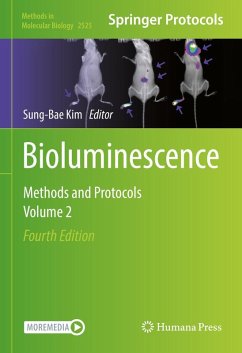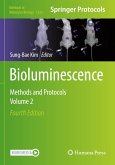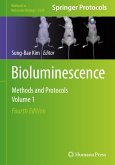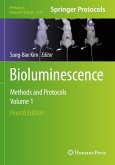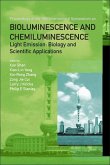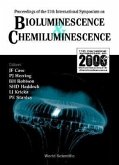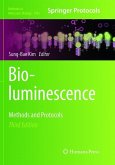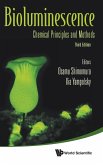Bioluminescence
Methods and Protocols, Volume 2
Herausgegeben:Kim, Sung-Bae
Bioluminescence
Methods and Protocols, Volume 2
Herausgegeben:Kim, Sung-Bae
- Gebundenes Buch
- Merkliste
- Auf die Merkliste
- Bewerten Bewerten
- Teilen
- Produkt teilen
- Produkterinnerung
- Produkterinnerung
This detailed collection explores recent advances in molecular imaging techniques involving bioluminescence, currently employed in biolaboratories around the world. Volume 2 delves into techniques for heterogeneous conjugates, protein fragment-complementation assays, BRET-based imaging, as well as instrumentation and software. Written for the highly successful Methods in Molecular Biology series, chapters include introductions to their respective topics, lists of the necessary materials and reagents, step-by-step, readily reproducible laboratory protocols, and tips on troubleshooting and…mehr
Andere Kunden interessierten sich auch für
![Bioluminescence Bioluminescence]() Bioluminescence116,99 €
Bioluminescence116,99 €![Bioluminescence Bioluminescence]() Bioluminescence164,99 €
Bioluminescence164,99 €![Bioluminescence Bioluminescence]() Bioluminescence116,99 €
Bioluminescence116,99 €![Bioluminescence and Chemiluminescence - Light Emission: Biology and Scientific Applications - Proceedings of the 15th International Symposium Bioluminescence and Chemiluminescence - Light Emission: Biology and Scientific Applications - Proceedings of the 15th International Symposium]() Bioluminescence and Chemiluminescence - Light Emission: Biology and Scientific Applications - Proceedings of the 15th International Symposium199,99 €
Bioluminescence and Chemiluminescence - Light Emission: Biology and Scientific Applications - Proceedings of the 15th International Symposium199,99 €![Bioluminescence and Chemiluminescence - Proceedings of the 11th International Symposium Bioluminescence and Chemiluminescence - Proceedings of the 11th International Symposium]() Bioluminescence and Chemiluminescence - Proceedings of the 11th International Symposium213,99 €
Bioluminescence and Chemiluminescence - Proceedings of the 11th International Symposium213,99 €![Bioluminescence Bioluminescence]() Bioluminescence82,99 €
Bioluminescence82,99 €![BIOLUMINESCENCE (3RD ED) BIOLUMINESCENCE (3RD ED)]() Osamu Shimomura & Ilia YampolskyBIOLUMINESCENCE (3RD ED)215,99 €
Osamu Shimomura & Ilia YampolskyBIOLUMINESCENCE (3RD ED)215,99 €-
-
-
This detailed collection explores recent advances in molecular imaging techniques involving bioluminescence, currently employed in biolaboratories around the world. Volume 2 delves into techniques for heterogeneous conjugates, protein fragment-complementation assays, BRET-based imaging, as well as instrumentation and software. Written for the highly successful Methods in Molecular Biology series, chapters include introductions to their respective topics, lists of the necessary materials and reagents, step-by-step, readily reproducible laboratory protocols, and tips on troubleshooting and avoiding known pitfalls.
Authoritative and comprehensive, Bioluminescence: Methods and Protocols, Fourth Edition, Volume 2 presents practical guidance for researchers and technical staff on how to proceed with bioluminescence studies in their laboratories.
Authoritative and comprehensive, Bioluminescence: Methods and Protocols, Fourth Edition, Volume 2 presents practical guidance for researchers and technical staff on how to proceed with bioluminescence studies in their laboratories.
Produktdetails
- Produktdetails
- Methods in Molecular Biology 2525
- Verlag: Humana / Springer US / Springer, Berlin
- Artikelnr. des Verlages: 978-1-0716-2472-2
- 4. Aufl.
- Seitenzahl: 444
- Erscheinungstermin: 15. Juli 2022
- Englisch
- Abmessung: 260mm x 183mm x 30mm
- Gewicht: 1027g
- ISBN-13: 9781071624722
- ISBN-10: 1071624725
- Artikelnr.: 63462397
- Herstellerkennzeichnung
- Springer-Verlag GmbH
- Tiergartenstr. 17
- 69121 Heidelberg
- ProductSafety@springernature.com
- Methods in Molecular Biology 2525
- Verlag: Humana / Springer US / Springer, Berlin
- Artikelnr. des Verlages: 978-1-0716-2472-2
- 4. Aufl.
- Seitenzahl: 444
- Erscheinungstermin: 15. Juli 2022
- Englisch
- Abmessung: 260mm x 183mm x 30mm
- Gewicht: 1027g
- ISBN-13: 9781071624722
- ISBN-10: 1071624725
- Artikelnr.: 63462397
- Herstellerkennzeichnung
- Springer-Verlag GmbH
- Tiergartenstr. 17
- 69121 Heidelberg
- ProductSafety@springernature.com
Quantitative Assessment of the Efficacy of Near-Infrared Photoimmunotherapy with Bioluminescence Imaging.- Evaluation of the Efficacy of Saracatinib-Loaded Nanoparticles in Lymphatic Metastases of HNSCC with the Aid of Bioluminescence Imaging.- Reactive Oxygen Species-Responsive and Self-Illuminating Nanoparticles for Inflammation and Tumor Imaging.- Antibacterial Activity Evaluation of ZnO, CuO, and TiO2 Nanoparticles in Solution and Thin Films.- BRET-Based Dual-Color (Visible/Near-Infrared) Molecular Imaging Using a Quantum Dot/EGFP-Luciferase Conjugate.- Polyhistidine-Tag-Enabled Conjugation of Quantum Dots and Enzymes to DNA Nanostructures.- Real-Time Quantification of Cell Internalization Kinetics by Bioluminescent Probes.- Quantitative Imaging of Retinoic Acid Activities in Living Mammalian Cells.- Bioluminescence-Based Complementation Assay to Correlate Conformational Changes in Membrane-Bound Complexes with Enzymatic Function.- The NanoBiT-Based Homogenous Ligand-Receptor Binding Assay.- Monitoring Hippo Signaling Pathway Activity Using a Luciferase-Based Large Tumor Suppressor (LATS) Biosensor.- Screening of Protein-Protein Interaction Modulators Using BRET Based Technology.- TRUPATH: An Open-Source Biosensor Platform for Interrogating the GPCR Transducerome.- MERLIN: A BRET-Based Proximity Biosensor for Studying Mitochondria-ER Contact Sites.- Single Cell NanoBRET Imaging with Green-Range Halo-Tag Acceptor.- Method for Measuring Bioactive Molecules in Blood by a Smartphone Using Bioluminescent Ratiometric Indicators.- BRET Sensors for Imaging Membrane Integrity of Microfluidically Generated Extracellular Vesicles.- In Vivo Assessment of Protein-Protein Interactions Using BRET Assay.- Live Cell Imaging of ATP Dynamics in Plant Cells.- Bioluminescence Resonance Energy Transfer for Global DNA Methylation Quantification.- In Vivo Bioluminescent Imaging of Bone Marrow Derived-Mesenchymal Stem Cells in Mice.- In Vivo Imaging of Oxidativeand Hypoxic Stresses in Mice Model of Amyotrophic Lateral Sclerosis.- ATP Sensing Paper with Smartphone Bioluminescence-Based Detection.- Organ Bioluminescence Imaging under Machine Perfusion Setting for Assessing Quality of Harvested Organ Preservation.- Time-Lapse Bioluminescence Imaging of Hes7 Expression In Vitro and Ex Vivo.- Bioluminescence-Optogenetics: A Practical Guide.- Applications of Bioluminescence-Optogenetics in Rodent Models.- One-Channel Microsliding Luminometer for Quantifying Low Energy Bioluminescent Lights.- Compact Eight-Channel Light Sensing System for Bioassays.- Characterization of Firefly Flashes at Various Temperatures in Different Wavelength Regions.- Bioluminescent Monitoring of Circadian Rhythms in Isolated Mesophyll Cells of Arabidopsis at Single-Cell Level.- Exploring Phylogenetic Relationships and Divergence Times of Bioluminescent Species Using Genomic and Transcriptomic Data.
Quantitative Assessment of the Efficacy of Near-Infrared Photoimmunotherapy with Bioluminescence Imaging.- Evaluation of the Efficacy of Saracatinib-Loaded Nanoparticles in Lymphatic Metastases of HNSCC with the Aid of Bioluminescence Imaging.- Reactive Oxygen Species-Responsive and Self-Illuminating Nanoparticles for Inflammation and Tumor Imaging.- Antibacterial Activity Evaluation of ZnO, CuO, and TiO2 Nanoparticles in Solution and Thin Films.- BRET-Based Dual-Color (Visible/Near-Infrared) Molecular Imaging Using a Quantum Dot/EGFP-Luciferase Conjugate.- Polyhistidine-Tag-Enabled Conjugation of Quantum Dots and Enzymes to DNA Nanostructures.- Real-Time Quantification of Cell Internalization Kinetics by Bioluminescent Probes.- Quantitative Imaging of Retinoic Acid Activities in Living Mammalian Cells.- Bioluminescence-Based Complementation Assay to Correlate Conformational Changes in Membrane-Bound Complexes with Enzymatic Function.- The NanoBiT-Based Homogenous Ligand-Receptor Binding Assay.- Monitoring Hippo Signaling Pathway Activity Using a Luciferase-Based Large Tumor Suppressor (LATS) Biosensor.- Screening of Protein-Protein Interaction Modulators Using BRET Based Technology.- TRUPATH: An Open-Source Biosensor Platform for Interrogating the GPCR Transducerome.- MERLIN: A BRET-Based Proximity Biosensor for Studying Mitochondria-ER Contact Sites.- Single Cell NanoBRET Imaging with Green-Range Halo-Tag Acceptor.- Method for Measuring Bioactive Molecules in Blood by a Smartphone Using Bioluminescent Ratiometric Indicators.- BRET Sensors for Imaging Membrane Integrity of Microfluidically Generated Extracellular Vesicles.- In Vivo Assessment of Protein-Protein Interactions Using BRET Assay.- Live Cell Imaging of ATP Dynamics in Plant Cells.- Bioluminescence Resonance Energy Transfer for Global DNA Methylation Quantification.- In Vivo Bioluminescent Imaging of Bone Marrow Derived-Mesenchymal Stem Cells in Mice.- In Vivo Imaging of Oxidativeand Hypoxic Stresses in Mice Model of Amyotrophic Lateral Sclerosis.- ATP Sensing Paper with Smartphone Bioluminescence-Based Detection.- Organ Bioluminescence Imaging under Machine Perfusion Setting for Assessing Quality of Harvested Organ Preservation.- Time-Lapse Bioluminescence Imaging of Hes7 Expression In Vitro and Ex Vivo.- Bioluminescence-Optogenetics: A Practical Guide.- Applications of Bioluminescence-Optogenetics in Rodent Models.- One-Channel Microsliding Luminometer for Quantifying Low Energy Bioluminescent Lights.- Compact Eight-Channel Light Sensing System for Bioassays.- Characterization of Firefly Flashes at Various Temperatures in Different Wavelength Regions.- Bioluminescent Monitoring of Circadian Rhythms in Isolated Mesophyll Cells of Arabidopsis at Single-Cell Level.- Exploring Phylogenetic Relationships and Divergence Times of Bioluminescent Species Using Genomic and Transcriptomic Data.

